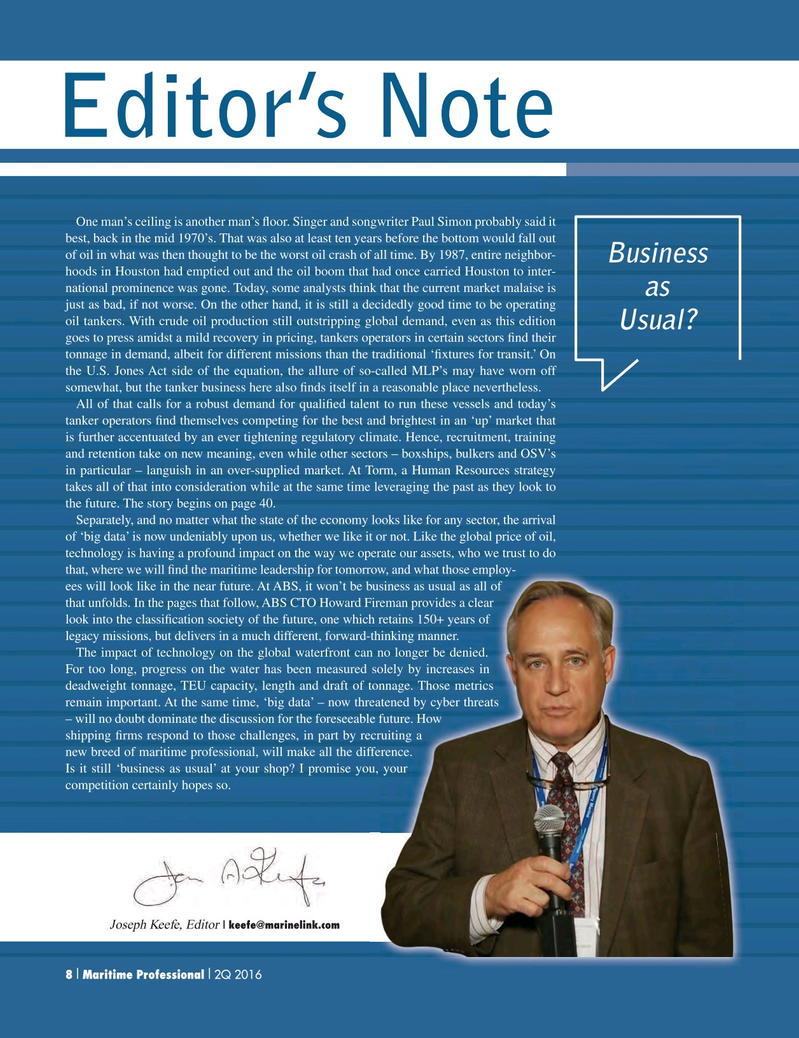
Page 8: of Maritime Logistics Professional Magazine (Q2 2016)
Energy Transport & Support
Read this page in Pdf, Flash or Html5 edition of Q2 2016 Maritime Logistics Professional Magazine
Editor’s Note
One man’s ceiling is another man’s ? oor. Singer and songwriter Paul Simon probably said it best, back in the mid 1970’s. That was also at least ten years before the bottom would fall out of oil in what was then thought to be the worst oil crash of all time. By 1987, entire neighbor-
Business hoods in Houston had emptied out and the oil boom that had once carried Houston to inter- national prominence was gone. Today, some analysts think that the current market malaise is as just as bad, if not worse. On the other hand, it is still a decidedly good time to be operating oil tankers. With crude oil production still outstripping global demand, even as this edition
Usual?
goes to press amidst a mild recovery in pricing, tankers operators in certain sectors ? nd their tonnage in demand, albeit for different missions than the traditional ‘? xtures for transit.’ On the U.S. Jones Act side of the equation, the allure of so-called MLP’s may have worn off somewhat, but the tanker business here also ? nds itself in a reasonable place nevertheless.
All of that calls for a robust demand for quali? ed talent to run these vessels and today’s tanker operators ? nd themselves competing for the best and brightest in an ‘up’ market that is further accentuated by an ever tightening regulatory climate. Hence, recruitment, training and retention take on new meaning, even while other sectors – boxships, bulkers and OSV’s in particular – languish in an over-supplied market. At Torm, a Human Resources strategy takes all of that into consideration while at the same time leveraging the past as they look to the future. The story begins on page 40.
Separately, and no matter what the state of the economy looks like for any sector, the arrival of ‘big data’ is now undeniably upon us, whether we like it or not. Like the global price of oil, technology is having a profound impact on the way we operate our assets, who we trust to do that, where we will ? nd the maritime leadership for tomorrow, and what those employ-row, and what those employ- ees will look like in the near future. At ABS, it won’t be business as usual as all of bus siness as usual as all of that unfolds. In the pages that follow, ABS CTO Howard Fireman provides a clear Fire eman provides a clear look into the classi? cation society of the future, one which retains 150+ years of h r retains 150+ years of -th h hiki legacy missions, but delivers in a much different, forward-thinking manner.hinking manner.
n n no longer be denied. The impact of technology on the global waterfront can no longer be denied. so olely by increases in For too long, progress on the water has been measured solely by increases in ton nnage. Those metrics deadweight tonnage, TEU capacity, length and draft of tonnage. Those metrics remain important. At the same time, ‘big data’ – now threatened by cyber threats ea atened by cyber threats e f future. How – will no doubt dominate the discussion for the foreseeable future. How shipping ? rms respond to those challenges, in part by recruiting a ecr ruiting a fference. new breed of maritime professional, will make all the difference.
Is it still ‘business as usual’ at your shop? I promise you, your u, your competition certainly hopes so.
Joseph Keefe, Editor | [email protected] 8 Maritime Professional 2Q 2016I I 1-17 Q2 MP2016.indd 8 5/19/2016 10:51:51 AM

 7
7

 9
9
